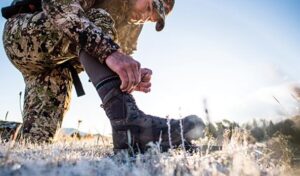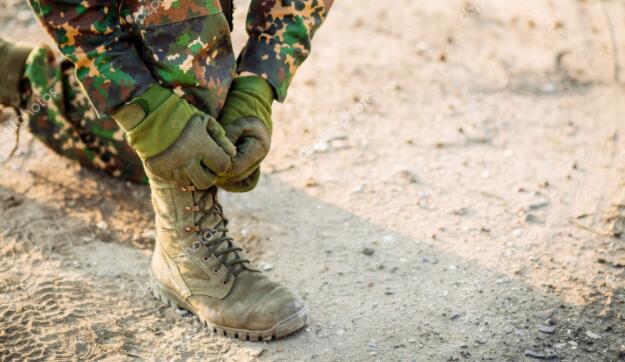Just like the excellent care, one takes when choosing your hunting destination, firearm, and dog before embarking on a hunting ordeal should also apply it or even more care when selecting the right height boots.
Little attention to your shoes can risk the whole hunting session being a waste of time, especially for late-season hunting when the weather is cold and calm. The right selection of boots ensures that the concentration is given to the hunting practice rather than your feet. It also leads to the development of a special bond (bond of trust). Due to the changing weather conditions during the late seasons, one must have an outstanding carefulness in his selection of boots.
Table of Contents
What Height Boots for Late-season Hunting?
The task of selecting the right type of boots for a hunting expedition during the late seasons, especially for beginners, can be very tiresome. Several hunters are struggling to find the right hunting shoes based on their prices and several unhelpful opinions, which are aided by the confusion brought about by the latest trends.
To ensure you choose the right boot for your hunting session from the different chunks in the market, there are several factors to consider when selecting the right boots. They include:

1. The fitness and comfort of the boot
It is the most crucial factor to consider when choosing the right boots for your late-season hunting. It’s critical to note that the convenience offered by the shoes in the market differs depending on the manufacturer’s designs. Some boots are naturally comfortable right from when they are removed from their box, while others, especially leather boots, take a particular amount of time to feel comfortable.
In this case, your boot should help you maintain your energy while taking the long walks through the forests. The comfort of the shoes also depends on the size of your boot. It’s key to note that long walks can cause your feet to lengthen and flatten up to even a full size larger hence the selection of boots that fit too much can lead to the development of blisters. It would help if you considered choosing boots that are a little bit larger than your feet.
2. The stability of the boot.
In most cases, the terrain of the forests (which range from unexpected rocks to creaks to plowed furrows) require boots with very high stability. It depends on the size of the sores of the boots’ ability to absorb shock without necessarily tearing apart, the ability to provide underfoot comfort, and above all, their ability to provide lateral stability.
The shape and tread of the boot, in this case, may also determine the balance of the boot. A rugged terrain requires grave threats while, on the other hand, a shallow tread helps the hunter limit the accumulation of mud on the shoes during the hunting session.
3. The materials of the boots
The materials used to manufacture a kick determines the quality of the boot. The quality of a kick determines its longevity or the amount of time the boot is going to last before it wears off, depending on the frequency of hour hunting expeditions.
To ensure that your boot lasts for long, always ensure that the boot is of leather material with the upper content made of a combination of leather and nylon fabric. Leather is currently the most outstanding fabric since its products are of high quality, lasts for long, flexible, and above all comes with an affordable price.
4. The temperature or the running weather
Especially for the late seasons, when the weather is cold and calm with low temperatures, you should ensure that your selected boots help keep your feet dry and warm. In most cases, Wet feet deter the hunter’s walking speed; hence, you should ensure that your shoes have waterproof components that help keep your feet dry whichever the terrain.
On the other hand, cold feet during this period may also ruin your hunting expedition within seconds. The cold weather, especially during these seasons, may make your feet numb. Hence, you require toasty and warm boots with a sizeable insulating material, which helps maintain the temperature in the shoes, therefore increasing the hunter’s comfort.
5. The weight of the boot
The selection of boots based on weight depends on the preference of the user. Most people may prefer heavy boots for various valid reasons. It’s key to note that heavy boots in most cases may hinder your movement (they slow down the speed of the hunter), they usually make the hunter tire faster since a lot of energy is concentrated on progress rather than hunting.
Best Hunting Boots For Late Season Recommend
Currently, some of the best available hunting boots for late seasons in the market include:

a.) Lowa Tibet GTX.
This type of hunting shoes can handle both harsh late-season weather conditions and terrains. The boot is crafted in Germany and has several features which include;
• A waterproof lining
• A stabilizer which provides the hunter with enough underfoot support
• A unique ankle flex design which increases the ease of walking
• A perforated lining which helps to control the climate
Pros:
• They are waterproof
• They are comfortable
• They are firm and supportive.
Cons:
• The sole edges are a little bit soft for climbing.
b.) Lowa Irox GTX
The Lowa Irox GTX generally is a complete combination of a sturdy mountaineering boot and a lightweight shoe. This shoe also has several unique features, such as:
• Footbeds which help in climate control
• Their tongues have both open and closed hooks which help in securing the laces
• Weatherproof membranes.
• The boot’s uppers are made up of lightweight synthetics to increase the speed at which it dries up.
Pros:
• They are waterproof
• They easily dry up
Cons:
• It has a funky color scheme
c.) Lowa Innox GTX
The Lowa Innox GTX boot can generally be described to be dynamic, light, and multifunctional because of its diverse features which include;
• A simple design of the sores which increases the boot’s stability
• A membrane which increases breathability of the boot
• A tall frame that increases the boots’ stability.
Pros:
• They are stable
• They are very flexible
Cons:
• They are very expensive.
Ways of ensuring that your height boots are your perfect fit.
The following are the various steps one should follow to ensure that your boots are your perfect fit.
1.) Begin with ensuring your socks are the right fit
Usually, socks are beneficial to the hunter since they improve the boot’s blood circulation, absorb moisture, especially for the late cold seasons, and reduce the bulk of the foot.
2.) Step two involves trying the boots on.
It’s meant to ensure that the shoes are fitting correctly, and at the same time, they allow your feet to move freely.
3.) Step three involves trying to hop, jump, and walking down on your knees.
This exercise ensures that your boots do not hinder your movement in any way during hunting. The move on your knees ensures that your shoes are free to reduce the heel’s tearing, especially for overfitting boots.
4.) Step four involves slowly rolling your ankle.
It’s done to test the support of the boot on the ankle.
5.) Step five involves pulling your feet out of the boot.
After pulling your feet out of the boot, check out for red spots on your feet. It’s meant to ensure that the shoes do not rub nor chafing against your feet. The persistence of rubbing may lead to the occurrence of blisters.
6.) Lastly, lace your boots in a heel lock pattern.
It’s meant to relieve the pressure the boot applies on the front of your foot hence reducing the chances of developing blisters.
Conclusion.
As discussed above, it’s critical to note that the choice of a hunter’s boots plays a crucial role in ensuring success or the hunting exercise’s failure. The choice of hunting boots does not necessarily depend on the latest trends and prices but rather on the unfavorable weather conditions of the new seasons and the harsh terrains in the hunting areas.




